Tag: vineyards
Bringing in the Grapes — Part V
Readers of ProjectSunlight have noted a recurring theme over the past month. The weather, at least insofar as vineyard mangers in Virginia are concerned, really sucked this year.
It may be small comfort to the Commonwealth’s vignerons, but the weather has generally sucked worldwide. Jancis Robinson, in her Financial Times column last weekend, detailed the carnage in California and Europe, and even in the Southern Hemisphere, where the growing season is reversed.
“If Europe’s vintners have found 2011 much more trying than any other recent vintage, six months earlier, while picking their 2011s, the Australians experienced the vintage from hell,” she wrote. “Harvest time in the supposedly sunny wine state of South Australia was sodden. Winemakers have had to work extremely hard in some areas to fashion drinkable wine out of bloated, rotten grapes.”
And it goes beyond Australia. “The vintage in New Zealand was bloated too, thanks to frenzied recent planting of vines there, fuelled by a belief that the world is in love with Kiwi Sauvignon Blanc,” she added. “Argentine growers were also afflicted by rain at harvest time in 2011, as well as the usual hail, and unusually late frost in November last year.”
So, weather-related problems span the globe. As I’ve noted before, that’s the way it is with agriculture. You really have no control over the weather, although you can compensate to some extent – to a great extent in normal years, less so in years like 2011 – with a disciplined spraying program.
And winemakers can exert some magic of their own once the grapes come in. This year will be difficult for sure, and none of the winemakers I’ve spoken to have any illusions about the challenges ahead of them. This vintage will definitely separate the men from the boys, so to speak, and show, as Ms. Robinson said, “who exactly are those master craftsmen.”
Bringing in the Grapes – Part III
I received a note today from Kirsty Harmon, winemaker and general manager at Blenheim Vineyards, and I thought I would draw from it to add a little bit to my last post. Kirsty was kind enough to take time out from this most difficult harvest to talk with our class, even though we had barely harvested as much, between the entire group, as a single member of a field crew would have picked in, oh, maybe 15 minutes? Remember, I did say in Part II
that we spent a lot of time staring at the vines, wanting to be sure that we didn’t add bad fruit to the lugs or leave good fruit on the ground.
In any event, we were working on half a section of Viognier that day. Kirsty had told us that they picked the first half a week earlier, due to advanced ripening at the top of the hill and indications that sour rot was starting to set in. Since it was clear that rain was on the way, Blenheim picked the first section which had ripened early, and let the rest hang on in the hope that it would continue to gain sugar and flavor.
The two types of rots that appeared on the grapes in the second section – Botrytis and sour rot – both make grapes mushy (both leak juice with a vinegary odor), and so by the time they would have made it back to the sorting table, they would have leaked all over he good fruit.
“Field sorting is labor intensive, but worthwhile,” Kirsty said. “I would say that many
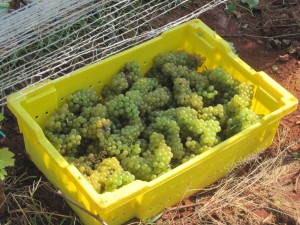
- We weren't very fast, but the fruit we added to the lugs sure looked good! Can't wait to taast the wine. 2011 Viognier.
wineries do take the time to do it though. Lots of wineries pick into bins rather than lugs, and not all wineries have the ability to sort when the fruit is picked into the half ton bins.”
You can see from the pictures in my last post how small lugs are. They are meant to bring grapes back to the crush pad or sorting table in good condition, without the weight of too many clusters at the top crushing those on the bottom.
Blenhein has almost completed its harvest. It has a small amount of Cab Franc remaining to be picked at the vineyard, and a few varieties in the Shenandoah Valley vineyards that it sources grapes from. You can bet that every winemaker and every vineyard manager will be glad to have all their fruit off the vine and into the fermentation tanks. It’s been that kind of year.
“This vintage has been the most challenging one of my career in Virginia,” said Kirsty. I think that almost every vineyard in the Commonwealth – and probably a good many in California as well – would agree.
WBC11 – A Conference for Wine Bloggers
I’ve been meaning for a week now to write something about the Wine Bloggers Conference (WBC11) that was held in Charlottesville July 22-24. It was a well-planned, well-executed conference, but what I think was most important about it for the purpose of this blog is the way it showcased Virginia’s wine industry. Some 325 bloggers from around the country attended, and they were all exposed in a variety of ways to Virginia wine.
While I was gathering my thoughts, I had occasion to read two really terrific posts from Frank Morgan on his blog, "Drink What You Like." I started to respond to the post, and my piece turned out to be too long for a comment – probably too long for a blog post, for that matter – so I decided to submit a trimmed-back version to his blog and run the extended piece here. If you haven’t yet seen Drink What You Like, trust me, it’s well worth a visit.
What’s great about these two posts (A View from the Punt, I and II) is the perspective it provides from “the other side of the bottle” – the views of those who were pouring their wines at this conference. I had actually been wondering what the winemakers, vineyard managers, marketing directors and others who poured during the conference thought about the event and about the bloggers. They pour (sorry for the pun) their lives into their wines, then pour the wines for people who sniff and swirl it for a few moments before rendering judgments that can be generous in their praise or critical to the point of being mean-spirited. Continue Reading–>
Meet the Vines: Fairfax — The Magnificent Seven
Well, I thought it was time to start introducing everyone to the vines I’ve planted, starting with the Fairfax vineyard. As I’ve said in the past, seven vines hardly constitutes a vineyard, and yet it’s big enough to yield enough grapes for five gallons of wine — about 30 bottles — when I get my first real harvest in three or four years. Not too shabby.
The vines in Fairfax are growing like Topsy, and I wonder sometimes if there’s too much vigor in this vineyard. Vines themselves are capable of amazing growth. They can grow higher than the trees in our yard, and we have really tall trees. But that’s not what we’re looking for. In these first few years, we want to funnel the energy of the vine into the development of the root system, and after that, into the grapes themselves. What we don’t want is for the vine itself to grow out of control, stealing vigor from the roots in the first years and the grapes thereafter.
The rootstock on these vines is of a type known as 101-14, which is a low vigor rootstock. And basically, I think we’re doing okay. We’ll see. But for now, let me introduce you to the Magnificent 7 (and believe me, they are magnificent!), one vine at a time. FYI, they are all Cab Franc.
First, here’s the back row, closest to the backyard fence (you can see a patch of Day Lilies, with a few unpulled weeds, on the other side of the fence). This row also has a rose bush between the two vines.
And here’s the middle row. The vines are all tied to faux bamboo poles. The large stake next to them is a leftover from the initial planting, before I had a fence up and was worried that the lawn service might mow them down without a few obstacles.
Finally, the third row, three vines strong. The middle vine is the giant of the group, nearly five feet tall, and the last is the runt of the litter. But I have every confidence that the little guy will produce great wine grapes someday, maybe the best in the vineyard.
So there it is. The vineyard ain’t huge, but it has loads of personality! And here’s a couple of shots that illustrate the humble beginnings of this patch of vines.
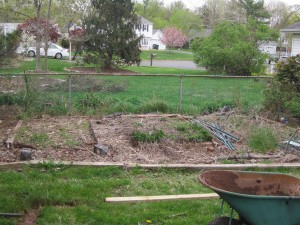
And here's a wider shot. Note the wheelbarrow in the foreground, a sure sign that I'm about to get my hands dirty.
Studying Viticulture at Monticello
It’s hard to imagine a better venue for the study of viticulture than Monticello, the home of America’s first great connoisseur of wine, and so I counted myself fortunate that this weekend’s class on vineyard diseases was taught on the small mountain that was Jefferson’s home.
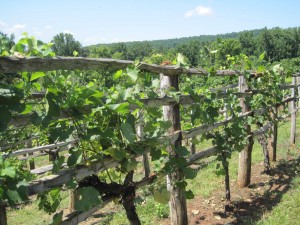
The vineyard at Monticello - just as Jefferson hoped it would be. Note the ancient trellising system.
I’m sure someone will question my description of Jefferson as the nation’s first great wine connoisseur, preferring another term in its place, but I think my words cover the subject better than any others. Jefferson is sometimes called America’s first great viticulturist, and the notebooks he kept while touring the world’s great wine regions reflect an extraordinary knowledge of the subject. Sadly, though, he was never successful in growing wine grapes at Monticello. But he loved wine – that too comes across in his notebooks – and he devoted huge sums of money, as well as significant amounts of his time, toward procuring and enjoying wine (more on this subject in a future post), and so it seems most accurate to think of him as not just a lover of wine, but as the young nation’s foremost authority on the subject. A connoisseur, and yes, much more than that.
Of course, Jefferson was an authority on many things, which is another reason why it seemed so special to be part of a class at Monticello. There are few people today, indeed, few people in history, whose expertise ranged over so many subjects. When you
consider how many hours that men of his age spent on the things we devote minutes or hours to – letters and travel, among them – it is nothing short of astonishing that Jefferson accomplished so much.
And for those of us (hopefully all of us) who care about the freedoms inscribed in the First Amendment, Jefferson is a name to be revered. While Madison may be the author of the First Amendment, Jefferson’s influence was vital. Free speech, free press, and the separation of church and state were central concerns for him. The Cavalier Daily, the student newspaper of the University of Virginia, where I worked for two years while occasionally attending classes, cited Jefferson proudly and perhaps defiantly in its masthead: “For here we are not afraid to follow truth wherever it may lead, not to tolerate any error, so long as reason is left free to combat it.” I always thought that quote was the most elegant and eloquent summation of the argument for a free press that I have ever heard.
Back to the class. It was taught by Gabriele Rausse, Monticello’s assistant director of gardens and grounds and the father of Virginia’s wine industry. Gabriele arrived in the United States in 1976 from his native Italy, thinking he needed to learn a bit more English before returning to the wine country of Australia, one of several wine regions he apprenticed in. At that time, the prevailing wisdom was that Vitis Vinifera, the great wine grapes of Europe, could not be grown in Virginia. Gabriele decided to contest the prevailing wisdom, even though, as he told us on Saturday, everyone thought he was crazy.
But of course, he was right.
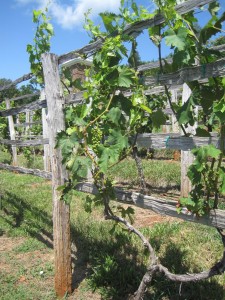
- Mammolo Toscanas at Monticello – and, yes, now you know where we got our Mammolos and why they are so important to us.
Today, Gabriele is the state’s best known vineyard consultant, and the wines he makes himself are elegant in the best traditions of Europe and, yes, Virginia. More on Gabriele in a future post, but for now, let me just say, that if you are lucky enough to taste his wines at a Virginia wine show, you should buy some, as it may be the only chance you get. His winery produces no more than 1,300 cases a year, so they are not only treasures, but they are rare.
Monticello and Gabriele. Life doesn’t get much better. I’ll post something in a few days about the class itself, but for now, I’ll just say that for those of us involved in the Virginia wine industry, even amateurs like me, the spirit of Jefferson will always be an inspiration.
Coming up next weekend: the North American Wineblogger’s Conference in Charlottesville. It says a lot about how far the Virginia wine industry has come that this conference is being held in Charlottesville, in the center of the Monticello AVA. And one of the events I am looking forward to most is the wine tasting at Monticello. It’s not like I’ve never been to a wine tasting, but the very idea of tasting wine at the home of Jefferson is humbling, to say the least.
I’m sure Jefferson will be watching over us, and wishing for just a sip of a true Virginia wine.
The Vineyard Goddess and the Potato Leafhopper
The Vineyard Goddess was not happy.
Our Nelson County vineyard was looking decidedly unhealthy. The leaves on the vines were pale, and they were full of holes. My wife, the Vineyard Goddess, spent hours inspecting the vines, looking through books, and searching the Internet for answers. Finally, she decided to email a photo of the not-so-healthy leaves to a Virginia Tech grape pathologist.
Virginia Tech’s Agricultural Research and Extension Center is a wonderful resource for Virginia Viticulturists, and they could not be more helpful. Within a few hours, she had an answer. It was most likely an insect that was doing the damage.
Although we hadn’t seen any bugs in the vicinity, the Vineyard Goddess decided to stake out the seven vines until she found what she was looking for. She didn’t have to wait long. There, on our Mammolo Toscano – I could almost hear her shriek, “not the Mammolo!” – were two tiny green bugs. They moved fast, but not as fast as the Vineyard Goddess.
Pinching one between thumb and forefinger, she carried it back to the house, combed through our viticulture books as well as the Internet, and made a positive ID. It was a Potato Leafhopper. We had never heard of a Potato Leafhopper, and had no idea why it had given up on potatoes and turned to our vineyard for nutrition. But it had.
It turns out that the Potato Leafhopper not only likes to munch on grape vine leaves, but it produces a toxic saliva that can dry up the leaves and mimic drought conditions. That explained a lot, including the curled leaves on our vines
VG immediately dusted the vines with a cure-all pesticide, and we both crossed our fingers.
Stay tuned for the next report from the front lines of our battle with this pest.
A Tale of Two Vineyards, Part I (In which the origin of the Fairfax vineyard is described.)
The decision to plant vines this year came after a lot of hand-wringing and was made only at the last minute. Looking back, it's hard for me to believe that we agonized so long over this decision. After all, we planted a grand total of 14 vines on two properties, not exactly a huge commitment of time or money. And now that we've worked a bit with them, most of
Digging out the old vegetable garden to make room for vines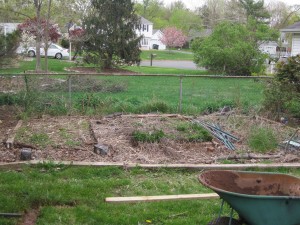
the concerns I had have long since faded away.
At the time, though, I wondered how we would find time to care for them. How we would manage the spray schedules. How we would get the soil ready. And how we would manage the trellising on such short notice.
We ended up planting two vines in Nelson County that were given to us after a class on vine grafting, and once we had those in the ground, we realized this was something we could do. So, I took a leap of faith and ordered a dozen Cab Franc vines from Double A Vineyards, figuring that by the time they arrived, we'd find a way to get the ground ready for planting at both the Fairfax and Nelson County sites. More on the Nelson County vineyard later.
The first pictures show the state of play in the Fairfax vineyard at the time I ordered the vines. It's part of an old garden, plus a bit of lawn that I decided to appropriate in order to provide room for three separate rows.
A closer look at the future Fairfax Vineyard - not a pretty sight, and not much time to prepare.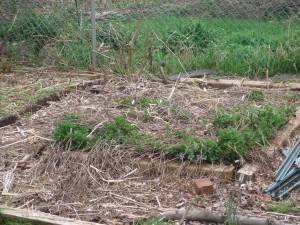
We're not talking big rows: two, with two vines each, and a third with three vines. But it's enough to provide grapes for five gallons of wine, just the right amount to ferment at home.
My first problem was finding the time to prepare the vineyard. We were going out of town most weekends (hanging out at the site of the Nelson County family vineyard), and it was getting dark early. Working when I could, I found time to clear out the growth in the garden, clear the sod in the lawn, and lay out the rows, using eight-foot metal fence posts as a guide. The rows were laid out seven feet apart, and the vines were to be spaced six feet apart.
The vines arrived on April 20, and I realized we would not have time to plant in Fairfax that week. Inside the packaging, the roots were wrapped with shredded newsprint that was still soaking wet. It was probably enough moisture, but I added a bit more water anyhow, and resealed the package. Anything worth doing is worth overdoing, in my humble opinion.
Overdone or not, the vines stayed healthy, and I planted the following week on April 26. Vines may be a bit too big of a word to describe what we actually planted. The plants consisted of a healthy-looking root (101-14 for those of you who care about such things – and if you are interested in establishing your own vineyard, you must care about such things), that ended with the graft union. What I was more familiar with was a plant that had both root and a scion, which is the particular type of vine. Cab Franc, for example, comes in a number of different clones and, again, for those of you who care about such things, these were FPS 04/332, grafted onto the 101-14 rootstock. Except that I couldn't see any part of the scion. In other words — and to get back on point — I was accustomed to seeing vines that looked like vines, not roots with a tiny stub of a graft union on top.
I called the nursery, and was told that the graft union had tremendous growth potential that would be unleashed if I simply hilled it over (covered it with dirt) and waited for the shoots to break through. I felt a bit like Jack and the Beanstalk being told to bury magic beans, but I did it anyhow, and three weeks later I had a bit of growth beneath the hilled-over soil. (It went a bit faster in Nelson County.)
In the foreground, a Cab Franc vine stands 25 inches tall. The one in the background a bit smaller.
We carefully cleared the hilled-over dirt away, making sure that the graft union was at least two inches above ground. The concern is that if the soil manages to come into contact with the scion above the graft union, the vine itself will begin to develop roots and will essentially be growing on its own root. This is a story for another time, but to make it quick, the vine has everything it needs to grow, including the ability to develop roots, but lacks one thing — resistance to Phylloxera, an insect that that nearly destroyed Europe's vineyards in the 19th century. That's why Vinifera vines (Merlot, Cab, Chard, pretty much every varietal you're accustomed to drinking) must be grafted onto American root stock, which is mostly immune to Phylloxera.
We let these vines grow without the grow tubes we used in the Nelson Vineyard. We worried about that decision for a long time (well, weeks) until we decided that grow tubes were creating more problems than they were solving.
In any event, these vines are doing pretty well.
They seem healthy and vigorous (hopefully not too vigorous), and the tallest of the group is about 25 inches. They need to be pruned back, but that's a story for next time. I've included three pictures, including one with Phoenix the Vineyard Dog standing guard from outside the fence.
One footnote: the fence serves to keep Phoenix out, but won't help with rabbits, deer or any of the other Bambi/Thumper-type predators that feed on vines. Very soon, we'll be putting up a deer fence, but for now we're counting on luck to keep these young vines safe.
Phoenix the Vineyard Dog standing guard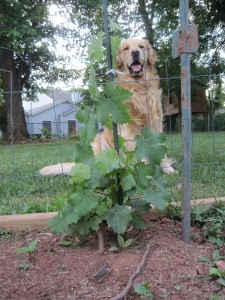
The Vines Emerge into the Sunlight!
- After two weeks, this Cab Franc vine emerges from the earth
- Three Cab Franc in the foreground, two Mammolo in the background
At long last — actually, it was only two weeks — the Cab Franc vines emerged from the soil. When we planted the vines, the graft union — the large swollen area where the root stock and the scion met — was hilled over, which is to say, we made a mound of dirt to cover the graft union. The graft union very quickly sent shoots up, and so this weekend, we removed the dirt that we had mounded over the vine, sprayed for all the diseases that Virginia humidity and (especially) rain can bring, and then place the blue-x grow tubes over the vines.
In this gallery, you see on the ends (I was having a problem with the software, and it was just easier to keep two of the same picture on the ends) a picture of three of the five Cab Franc vines, plus two of the Mammolo Tuscano that we planted earlier, the Mammolos being a gift from Gabrielle Rausse, one of Virginia’s great winemakers. In the middle, is a picture of the vine that emerged from the graft union that was still buried.
As Gabrielle said to us in a class, “the vine is so smart.” It definitely knows what to do. A small cutting from the vine can be made to both bud at one end — giving rise to a vine that will bear fruit — and take root at the other. Unfortunately, Vitis Vinifera vines from Europe cannnot grow on their own roots here in the U.S. They will die from Phylloxera (which nearly destroyed the entire wine industry in Europe in the 19th century) or some other North American disease. To survive, the Vinifera vine must be grafted onto American rootstock. The rootstock my vines are grafted onto is known as 101-14.
With luck, we’ll be making wine from these vines in three short years!
Bob

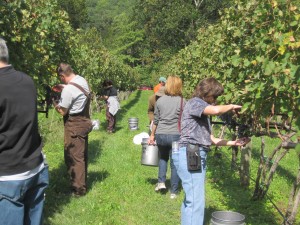
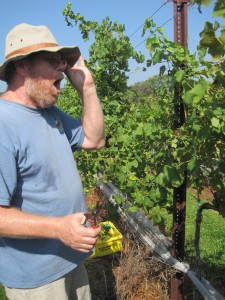
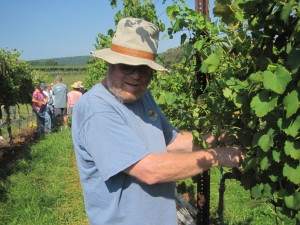
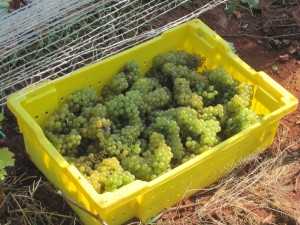
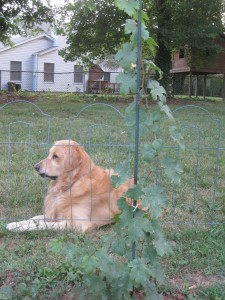
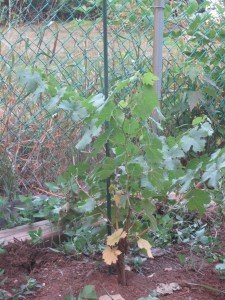
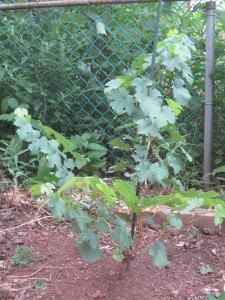
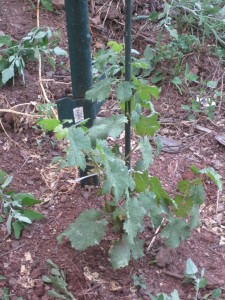
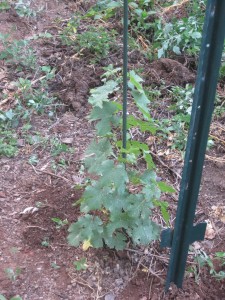
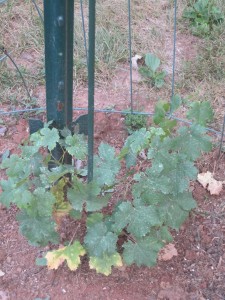
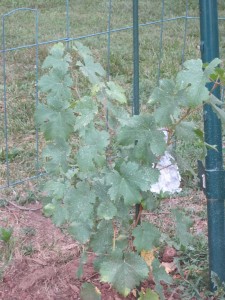

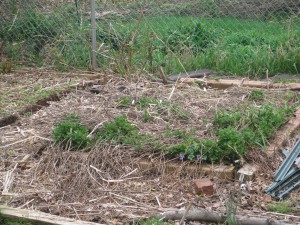
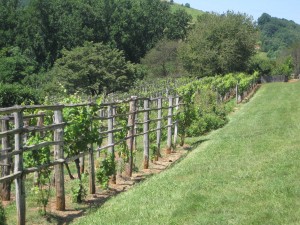
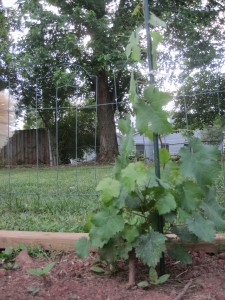
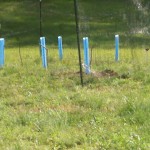
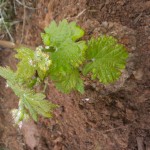
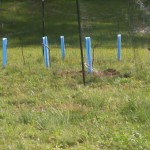


Recent Comments